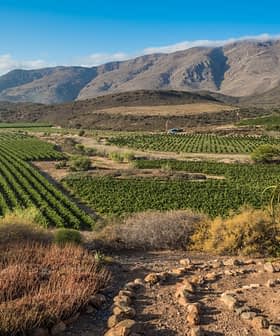In Western Argentina, Rising Energy Costs Worry Some Olive Growers
As Argentina's energy minister deregulates the sector and electricity costs shoot up, olive farmers are feeling the effects.
As Argentine olive growers enter an off-year after a record-setting harvest in 2017, some oil producers are becoming more worried about rising production costs.
It is serious because the way of charging electric power has changed, today the government wants to charge it without subsidies.
Increasing costs of electricity, which is required by many olive growers in the more arid provinces of San Juan and La Rioja to power water pumps, have shot up by 200 to 600 percent. In a region that does not receive much rainfall, but benefits from deep-lying underground aquifers, these pumps are vital to crop production.
These huge increases to farmers’ electricity bills have largely come from reforms that are currently being made to the energy sector, along with increases to national, provincial and municipal taxes.
Javier Iguacel, Argentina’s new energy minister, told Bloomberg News that the deregulation of Argentina’s energy sector was necessary to conform with the International Monetary Fund’s demands for the government to balance its books.
“We’re going to get out of the current system,” he told Bloomberg News. “Generators will buy direct from producers, and large-scale consumers and distributors will buy direct from generators.”
Julián Clusellas is the president of the Rio de la Puerta olive oil company. He said that while other factors, such as labor costs and a fluctuating global market are impacting the company’s bottom line, the electricity hikes are hurting the most.
“What impacts us most in costs is electricity,” Clusellas said. “It is serious because the way of charging electric power has changed, today the government wants to charge it without subsidies.”
These rising costs come at an inconvenient time for western Argentine growers. Olive and olive oil prices have not increased recently and the potential for a free trade agreement between the European Union and Mercosur also threatens the sector.
Many olive farmers and oil producers are concerned that no provisions for the protection of domestic olive markets have yet been made in talks that are likely to begin winding down soon. They worry that newly tariff-free Spanish, Greek and Italian olives and olive oils will soon flow onto supermarket shelves, competing with domestic products.
Cutting production costs is the logical way to remain competitive, but many farmers simply cannot see an easy way of doing so. Lowering labor costs is one option, but many argue that wages are so low that this would drive those who do work on olive farms to find other work.
“[Olive cultivation requires] a lot of fixed and specialized manpower to maneuver the machines and the field, but also transient [labor] to prune,” Clusellas said. “The impact of labor is already a lot and we can not reduce labor because people earn little.”
Since cutting labor costs is out of the question for many, the next option becomes decreasing the amount of water that is pumped out of the ground for irrigation. However, farmers who have already tried this say it leads to lower olive yields of inferior oil quality.
“By lowering the volume of water received by the olive tree, we directly affect the olive grove,” Fabián Famar, a consultant at the San Juan olive chamber, said. “And knowing that if we reduce irrigation, we also decrease production and quality.”
Clusellas agrees that less irrigation simply will not work for the region. Techniques that are used in other arid olive-growing regions, such as Andalusia, may be the alternative. He acknowledged that drip irrigation could be a solution.
“We can not irrigate less because our production would fall and we would harvest crops below the equilibrium point,” he said. “In our region olives must be grown with a high rate of production to sustain the farmers, which means that it must be above 10 tons per hectare per year.”
Due to the off-year, this year’s production in the region is going to be far less than that. However, many olive oil producers and exporters are optimistic that next year will lead to yet another record year of production. Depending on the outcome of the EU-Mercosur trade agreement, some producers believe this will be enough to keep olive farmers afloat.
“We expect a very good crop for 2019,” one producer and exporter from the region said.
However, Clusella believes that farmers must not make decisions based on predictions. This is ultimately why he sees increasing energy prices as the main issue for olive growers in the region.
He also thinks that regardless of the 2019 crop size, international markets will be different and olive grower profits will not be as high.
“I do not think [the profits from next year’s harvest will compensate for this year’s losses] since the 2018 cycle benefited from international prices above 30 percent of the current price due to the fall of production in the Northern Hemisphere,” he said. “I do not think that this can be repeated. So that the income in 2019 will be less than the amount of 2017.”








